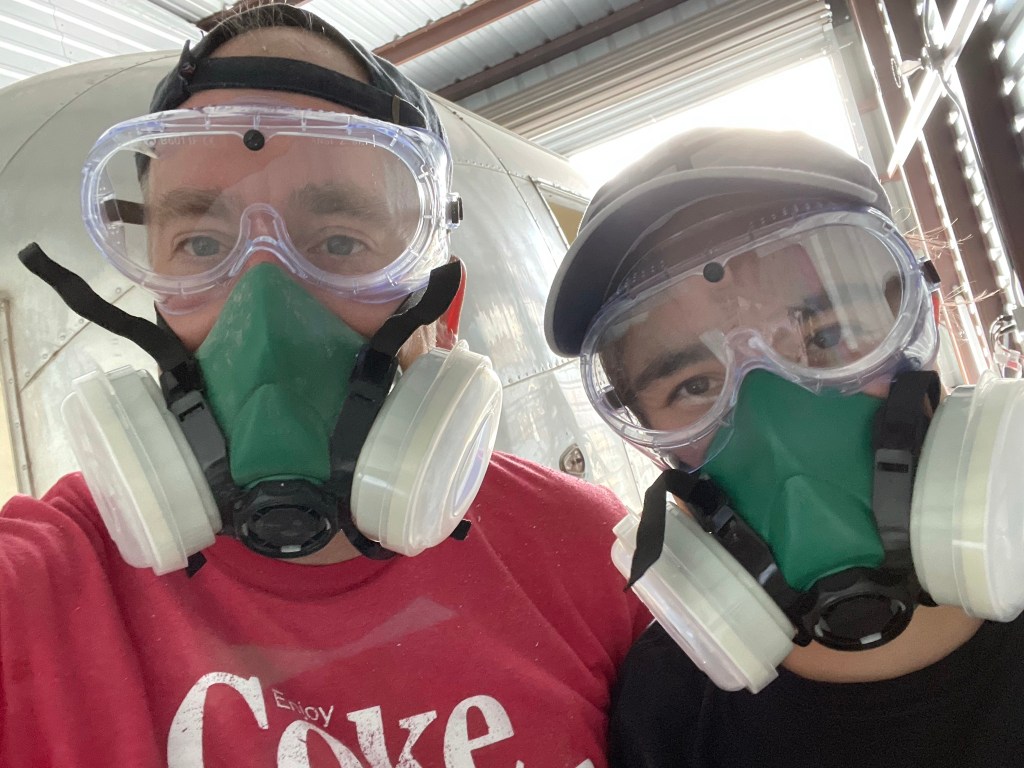When we took apart the frame, we were surprised to find the frame and fasteners were significantly corroded. The frame crossmembers underneath the vanity was paper thin, the fasteners which held the sub-floor the frame were so embrittled that they snapped off when we tried to remove them.
This was a little concerning to me since I wanted to understand the mechanism to prevent it from happening again.
Galvanic Corrosion: My initial thought was that the predominant corrosion mechanism was galvanic corrosion. Galvanic (or two-metal corrosion) occurs when two metals of different potential (affinity for electrons) are in electrical contact within a corrosive environment. Simply put, the more anodic (i.e., lower EMF metal – Aluminum in this case), gives up its electrons to the more noble metal (Iron in this case). The electrons travel to a place where they can react in an oxidation reaction.
In case you were not aware, Airstreams are constructed with Aluminum and Steel in physical contact with one another, setting the stage for galvanic corrosion to occur.

In Corrosion Engineering, Fontana discusses that galvanic corrosion usually occurs at the metal-metal interface with the corrosion occurring on the more anodic metal (Aluminum). Fontana also discusses a phenomenon known as the area effect in which a large anodic surface areas (e.g., large Aluminum shell) in contact with small cathode interface area (e.g., small steel bolts) will tend to slow the reaction.
In short, what I would’ve seen if galvanic attack was the source of the corrosion was corrosion of the aluminum at the Al-Fe interface. In fact, all of the corrosion I saw was of the iron components (bolts and frame). This indicates that the corrosive mechanism was not galvanic attack.
Now that galvanic was ruled out as a source of corrosion, I started to think about other mechanisms. Looking at the frame showed general overall corrosion with areas of greater thinning. In other words, the whole thing rusted but some areas were worse than others.
Uniform Attack (aka Rust): Per Fontana, uniform attack is the most common form of corrosion and is characterized by an electrochemical reaction that proceeds uniformly over the entire exposed surface. This was the case for most of the frame and it is assumed to be this was the primary source of corrosion.


Hmmm . . . why was the rust really bad in some spots, and not others? Doesn’t sound very ‘uniform’ to me!
Environmental Conditions Affecting Corrosion: You may be wondering why some areas corroded worse than others if the mechanism was essentially the same. The reason can be found in the abundance of oxidizers at the corrosion site.
The presence of oxygen and water will increase the oxidation reaction at the place where those chemicals can be found. The photos above show two such locations: The annular space between the inner and outer shell, and the frame area directly below the bathroom sink. Presumably the outer shell and piping to the sink both leaked.
Representative anodic reaction: Fe -> Fe2+ + 2e–
Most likely cathodic reaction: O2 + 2H2O + 4e– -> 4OH–
Wood Rot: The old sub-floor was made of plywood. Plywood is also susceptible to damage relating to water exposure. However, in this case, it’s susceptible to water absorption, rot and molding. The picture below shows the joint between the sub-floor, c-channel and shell (near the door) and is representative of the wood rot that existed throughout the trailer.

Corrosion Prevention: It’s unrealistic to assume we can stop all corrosion, but it is reasonable to assume we can slow it down to so that the trailer lasts another 57 years. Here is what we are considering.
- Prevent oxidation from occurring at the frame’s metal/air interface by removing that interface through the use of spray-on coatings (i.e., primer & insulation).
- Leak-proof the exterior shell. to prevent water from getting into the annular space
- Select insulating material which will not hold water (i.e., won’t hold oxidizing medium)
- Insulate the iron fasteners from the aluminum shell using gasketing material
- Allow for drainage in the shell annular space.
- Sacrificial anode (i.e., zinc anode, or zinc galvenization) of the frame so that when oxidation occurs, the metal giving up its electrons is not the steel . . . . or the Aluminum.
- Different sub-floor material which is not susceptible to wood rot and/or water absorption.























